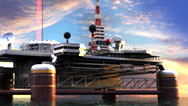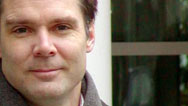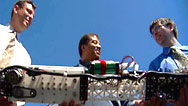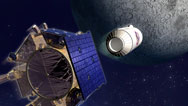Space Elevator
- Posted 01.09.07
- NOVA scienceNOW
(This video is no longer available for streaming.) It costs about $500 million to take the space shuttle out for a spin. But what if there was another way to get to space? And what if that way were as easy and as cheap as riding an elevator? Well, some people think this kind of trip might be possible someday, thanks to something known as the Space Elevator, a 22,000-mile-long cable that could lift people and payloads straight to outer space.
Transcript
SPACE ELEVATOR
PBS Airdate: January 9, 2007
NEIL DEGRASSE TYSON: You're watching NOVA scienceNOW. Still to come on NOVA scienceNOW:
WILLIAM SATURNO: When I shone my flashlight up on the wall, I saw the face of the Maya maize god there. I thought, "Well, I found this amazing thing, and I'm going to die right here, and someone is going to find it and me in 20 years."
NEIL DEGRASSE TYSON: But first, did you ever think about taking a vacation in orbit? Sounds ridiculous, right? Well, when the Space Needle, here in Seattle, was built, in 1962—back at the dawn of the Space Age—lots of people thought they would soon be taking trips just like that.
Of course, hasn't quite worked out that way. It costs about half a billion dollars just to take the space shuttle out for a spin. Kind of an expensive vacation isn't it?
One, please. Thank you.
But what if there was another way to get to space? And what if that way were as easy and as cheap as riding an elevator? Well, strange as it sounds, some people think this kind of trip might just be possible one day, thanks to something known as the Space Elevator, a 22,000-mile long cable that we could ride straight to outer space.
STEPHEN STEINER: What we're talking about is building the biggest thing ever.
NEIL DEGRASSE TYSON: And what enables this big idea is the discovery of something so small, you can't even see it with the naked eye: a new material called a "carbon nanotube." Fueled by the promise of these tiny tubes, people are already working to turn the Space Elevator into a reality.
BRADLEY EDWARDS (Black Line Ascension): It's basically a fairly straightforward system once you get down to the nuts and bolts of it.
First, launch a satellite to geosynchronous orbit, 22,000 miles above Earth. Then, lower a cable or ribbon and attach it to a platform at sea. Clamped to the ribbon, elevator cars, or climbers, could carry people and payloads up and down. Lasers, on the ground, would beam energy wirelessly to solar cells on the underside of the climber, powering electric motors for the 22,000-mile journey.
NEIL DEGRASSE TYSON: Okay, I know what you must be thinking, "A 22,000-mile elevator ride? These people are nuts. Like, what would even hold it up?" Well, the idea is not quite as crazy as it sounds.
STEPHEN STEINER: Imagine I have a yo-yo in my hand. As you spin the yo-yo around, the body of the yo-yo is thrust outward and the string connecting you to the yo-yo is held taut. Well, this is the same principle that would keep the Space Elevator up. We're basically making a planet-sized yo-yo.
NEIL DEGRASSE TYSON: A Space Elevator could be safer and cheaper than rockets, giving routine access to the solar system.
Bringing this far-out idea down to earth, NASA recently funded a competition, in New Mexico, to build and race Space Elevator prototypes. It was held at the X Prize Cup, a carnival of cutting-edge space technology.
In the tradition of competitions that stretch farther back than Charles Lindbergh's transatlantic flight, the aim is to inspire new advances in technology.
This year, teams of students and weekend inventors are vying for the $150,000 in prizes in the Space Elevator contest.
MATTHEW ABRAMS (StarClimber Space Elevator Team): I heard about this competition, and I thought, "Wow! You don't have to have a billion dollars and an aerospace company to do this."
BRIAN TURNER: We're definitely at the cutting edge. You're going to see stuff go wrong today.
NEIL DEGRASSE TYSON: The racetrack is a 50-meter ribbon suspended from a crane. Teams had to design and build climbers, then race them to the top of the ribbon. In place of the laser that might otherwise power a real Space Elevator, they could use only energy from the sun or beamed from the ground.
The best time wins, as long as you go faster than a meter per second.
One of the first to try their luck is a high school team from Germany with an elevator sporting an intimidating solar panel and name.
JOERN LUTAT (Max Born College): Turbocrawler.
NEIL DEGRASSE TYSON: Turbocrawler. All right! That sounds mean. Sounds, sounds like it's going to win.
But as Turbocrawler is about to take off, the wind picks up, Turbocrawler gets out of hand, and the Germans are grounded, at least for the time being.
Julie Bellerose and her team from the University of Michigan are next to jump on the ribbon.
ROGER GILBERTSON (The Spaceward Foundation): The whole big idea behind doing this is to get engineers in school to start working on this. At the end of this event there are kids here who are going to know more about Space Elevator technology than NASA scientists are.
NEIL DEGRASSE TYSON: Julie's climber is powered by a dozen spotlights that each have to track the solar panels all the way up the ribbon.
JULIE BELLEROSE (University of Michigan): Light on!
NEIL DEGRASSE TYSON: The climber gets off to a good start. But the higher it rises, the harder it becomes to hit the solar panels with the spotlights, to keep it going.
JULIE BELLEROSE: ...Number 4.
NEIL DEGRASSE TYSON: After about 6 minutes of stopping and starting, the climber reaches the top.
JULIE BELLEROSE: We didn't make it in the time required, but I think one of the goals is to make it to the top, so we're very happy.
NEIL DEGRASSE TYSON: NASA's prize money is safe, at least until the contest resumes the next day.
Now, if you think the whole idea of an elevator to space sounds like science fiction, you're right. It was popularized in the late 1970s in a sci-fi novel called The Fountains of Paradise by Arthur C. Clarke.
ARTHUR CLARKE: (Author, The Fountains of Paradise): At last we can build a space elevator. And then we will have a stairway to heaven, a bridge to the stars.
NEIL DEGRASSE TYSON: But as long as people have dreamed of building that bridge to the stars, no material existed to make a cable that's strong enough. That is, until we found that one of nature's most common atoms, carbon, was leading a secret life.
STEPHEN STEINER: I wouldn't say carbon is promiscuous. I would just say it's very open-minded.
NEIL DEGRASSE TYSON: Carbon atoms just love to form extremely strong chemical bonds with one another. We knew they could be arranged in a lattice to form diamond or in sheets to form graphite. But until recently, we had no idea they could also form tiny spheres called "buckyballs" and tiny tubes called "carbon nanotubes."
Much stronger and lighter than steel, and able to conduct electricity, these cylinders of pure carbon have been called a wonder material, a new building block that might be used in everything from electronics to airplanes.
But as a Space Elevator cable, carbon nanotubes have some big problems: the longest ones ever made are only a few centimeters. And joining them together end to end, one at a time, is simply not practical. So how would we ever use these tiny tubes to make a cable that's 22,000 miles long?
Deep in the heart of Texas, scientists are taking a different approach to assembling carbon nanotubes.
RAY BAUGHMAN: It's the dream of the future, but it's an achievable dream.
NEIL DEGRASSE TYSON: To make a batch of carbon nanotubes, bake a silicon plate coated with iron particles, at 1,300 degrees Fahrenheit, in a special oven. Then, add a dash of acetylene, a gas that contains carbon.
When acetylene comes in contact with the iron, it releases its carbon atoms, which assemble—as seen here—into nanotubes.
When the plate comes out, it's coated with a black soot that contains trillions of carbon nanotubes, all aligned vertically in what Ray Baughman calls a "forest."
RAY BAUGHMAN: Think of a bamboo forest.
NEIL DEGRASSE TYSON: But unlike a real bamboo forest, the trees in a nanotube forest tend to stick together, thanks to a faint force operating at the nanoscale called the Van der Waals force. It's sort of like magnetism.
RAY BAUGHMAN: So, when you pull one nanotube out, you pull its neighbors. And then they pull out their neighbors.
NEIL DEGRASSE TYSON: Pulling a whole row of nanotubes from the forest on the left, they can draw out a ribbon of pure carbon nanotubes, held together by nothing but the Van der Waals force.
This ribbon is less than one-thousandth the thickness of a human hair, and it's stronger than steel.
But can nanotube ribbons ever be made strong enough for a Space Elevator cable?
RAY BAUGHMAN: That is an unresolved question, but in science and technology, I've learned to never use the word "never."
NEIL DEGRASSE TYSON: Back in New Mexico, the mood is more optimistic as the second day of the Space Elevator competition gets underway.
Among those hoping to claim NASA's $150,000 prize is Brian Turner, captain of a truly homegrown team, the Kansas City Space Pirates.
BRIAN TURNER: I've got my dad, my step-dad, my mom, my uncle...great-uncle Max.
NEIL DEGRASSE TYSON: Uncle Max. I'm Neil Tyson.
MAX: Neil.
NEIL DEGRASSE TYSON: All right. You're one of the family affair. If you win, that probably means more to you than just getting the money.
MAX: Oh, yeah.
BRIAN TURNER: I don't know. I think...
NEIL DEGRASSE TYSON: Hoping to make their elevator sail up the ribbon, the Space Pirates pull out their secret weapon: 15 mirrors, each the size of a twin bed.
BRIAN TURNER: One person on each mirror.
NEIL DEGRASSE TYSON: Beaming sunlight to your collecting mirror?
BRIAN TURNER: Right.
NEIL DEGRASSE TYSON: To the solar panel?
BRIAN TURNER: Right.
NEIL DEGRASSE TYSON: Giving the energy to climb.
BRIAN TURNER: Right.
ANNOUNCER: Are you ready? All right, here we go.
NEIL DEGRASSE TYSON: Halfway up the ribbon, the wind kicks in again.
BRIAN TURNER: Got to get up there. I'm going to go look at it this way.
NEIL DEGRASSE TYSON: Bouncing in the breeze, the parabolic mirror can't stay focused on the solar cells, and the Pirates' elevator grinds to a halt.
BRIAN TURNER: Come on. Come on.
If the wind hadn't been bucking, I might have been better off. But I can't believe I didn't make it to the top. I figured I could fight my way up there.
NEIL DEGRASSE TYSON: Next up, and favored to win, is the University of Saskatchewan Space Design Team, or USST, for short.
TEAM MEMBER: Go time, right? It's go time.
NEIL DEGRASSE TYSON: Their secret weapon: a stationary mirror to reflect a spotlight straight up the ribbon to the solar array.
TEAM MEMBER: Phase one.
NEIL DEGRASSE TYSON: It looks like they make it to the top in record time, fast enough to claim the $150,000 prize.
So did they win?
BEN SHELEF (The Spaceward Foundation): We have to have a little discussion about that.
NEIL DEGRASSE TYSON: Before the prize money can be awarded, the remaining teams get one last chance.
The German Turbocrawler crawls all the way to the top, but it's no prize winner.
And late in the day, a team of high school students from California posts an impressive two-minute run.
EVAN JOHNSON: It's pretty good that we got 2:02.
JEFFREY GRATTAN: It's going on our resumes.
NEIL DEGRASSE TYSON: But in the end, the prize money went unclaimed, because it turns out Saskatchewan fell just short of the minimum speed of one meter per second.
CLAYTON RUSZKOWSKI (University of Saskatchewan Space Design Team): Next year, most of us are coming back, and we're going to just totally take it up two notches and just go all out.
NEIL DEGRASSE TYSON: But will we ever take a ride in a real Space Elevator?
STEPHEN STEINER: I think it's crazy, but I still think it's possible. And I think it's something that, if we can do it, we should do it.
NEIL DEGRASSE TYSON: Well, one thing's for sure, we have a long way to go before that happens. But, who knows? Perhaps someday technology will catch up with our imaginations and take the Space Elevator out of the realm of science fiction once and for all.
Credits
Space Elevator
- Edited by
- Nathan Hendrie
- Written, Produced and Directed by
- Joseph McMaster
NOVA scienceNOW
- Executive Producer
- Samuel Fine
- Executive Editor
- Neil deGrasse Tyson
- Senior Series Producer
- Vincent Liota
- Supervising Producer
- Stephen Sweigart
- Editorial Producer
- Julia Cort
- Development Producer
- Vinita Mehta
- Program Editor
- David Chmura
- Post Production Supervisor
- Win Rosenfeld
- Unit Manager
- Candace White
- Associate Producers
- Mica McCarthy
- John Pavlus
- Win Rosenfeld
- Anna Lee Strachan
- Production Secretary
- Fran Laks
- Animator
- Brian Edgerton
- Compositor
- Yunsik Noh
- Camera
- Edward Marritz
- Robert Hanna
- Anthony Forma
- Peter Bonilla
- Stephen McCarthy
- Sound Recordists
- Alex Sullivan
- Michael Karas
- Mark Mandler
- Steve Jones
- Rusty Duggan
- Audio Mix
- John Jenkins
- Colorist
- Jim Ferguson
- Animation
- Sputnik
- Vincent Liota
- Space elevator animation by Space Elevator Visualization Group
- Visual Effects Supervisors
- Alan Chan
- Lee Stringer
- Digital Artists
- Eki Halkka
- Michael Cliett
- Matt Zeyn
- Jeff Leroy
- Jackson Yuen
- Consultant
- Brad Edwards
- Additional Editing
- Patricia Stern
- Win Rosenfeld
- Music
- Rob Morsberger
- NOVA scienceNOW Series Animation
- Edgeworx
- Archival Material
- Philip Baird/AnthroArcheArt.org
- Robert Frerck/Odyssey Productions/Chicago
- Getty Images
- HarperCollins Publishers, Inc. (Arthur Clarke recording)
- NASA
- Longevity Study Participants
- Barbara Brody
- Irma Daniel
- Sylvia Goldberger
- Frances Horowitz
- Toby Kirsh
- Louis Levinson
- Arthur Stern
- Special Thanks
- Harry's Coffee Shop
- Mike Jorgenson/WPRB
- Jason Saunders
- Arthur C. Clarke
- Rohan de Silva/The Arthur C. Clarke Foundation
- Oak Ridge National Laboratory
- Ray Baughman
- University of Wollongong
- The Space Needle Corporation
- Wirefly X PRIZE Cup
- LiftPort, Inc.
- Neil deGrasse Tyson
- is director of the Hayden Planetarium in the Rose Center for Earth and Space at the American Museum of Natural History.
- NOVA Series Graphics
- yU + co.
- NOVA Theme Music
- Walter Werzowa
- John Luker
- Musikvergnuegen, Inc.
- Additional NOVA Theme Music
- Ray Loring
- Post Production Online Editor
- Spencer Gentry
- Closed Captioning
- The Caption Center
- NOVA Administrator
- Ashley King
- Publicity
- Eileen Campion
- Anna Lowi
- Yumi Huh
- Lindsay de la Rigaudiere
- Researcher
- Gaia Remerowski
- Production Coordinator
- Linda Callahan
- Unit Manager
- Carla Raimer
- Paralegal
- Raphael Nemes
- Legal Counsel
- Susan Rosen Shishko
- Assistant Editor
- Alex Kreuter
- Associate Producer Post Production
- Patrick Carey
- Post Production Supervisor
- Regina O'Toole
- Post Production Editor
- Rebecca Nieto
- Post Production Manager
- Nathan Gunner
- Producers, Special Projects
- Susanne Simpson
- Lisa Mirowitz
- Coordinating Producer
- Laurie Cahalane
- Senior Science Editor
- Evan Hadingham
- Senior Series Producer
- Melanie Wallace
- Managing Director
- Alan Ritsko
- Senior Executive Producer
- Paula S. Apsell
This material is based upon work supported by the National Science Foundation under Grant No. 0229297. Any opinions, findings, and conclusions or recommendations expressed in this material are those of the author(s) and do not necessarily reflect the views of the National Science Foundation.
NOVA scienceNOW is a trademark of the WGBH Educational Foundation
NOVA scienceNOW is produced for WGBH/Boston by NOVA
© 2007 WGBH Educational Foundation
All rights reserved
- Image credit: (space elevator) Courtesy Bradley C. Edwards/Space Elevator Visualization Group
Participants
- Evan Johnson & Jeffrey Grattan
- Westmont High School westmont.cuhsd.org/
- Matthew Abrams
- StarClimber
- Ray Baughman
- The University of Texas at Dallas www.nanotech.utdallas.edu/personnel/staff/baughman.html
- Julie Bellerose
- University of Michigan data.engin.umich.edu/s3fl/mclimber/
- Bradley Edwards
- Black Line Ascension www.bradleyedwards.info/Biography.html
- Ken Elliot
- University of Saskatchewan Space Design Team
- Roger Gilbertson
- The Spaceward Foundation www.spaceward.org/
- Joern Lutat
- Max Born College www.space-elevator.de.vu/
- Clayton Ruszkowski
- University of Saskatchewan Space Design Team
- Ben Shelef
- The Spaceward Foundation www.spaceward.org/
- Stephen Steiner
- Massachusetts Institute of Technology
- Brian Turner
- Kansas City Space Pirates www.kcspacepirates.com/
Related Links
-

Why Build a Space Elevator?
Physicist and space-elevator visionary Brad Edwards describes the benefits we'd enjoy with a 22,000-mile cable to space.
-

Space Elevator: Expert Q&A
Physicist Brad Edwards answers questions about the space elevator.
-

An Elevator to Space?
In this video extra, see a prototype of a technology that may one day take us to space.
-

Moon Smasher
A NASA satellite called LCROSS heads to the moon in hope of finding buried water.
-

A Nanotube Space Elevator
Find out about the discovery of a new building material, the carbon nanotube.



